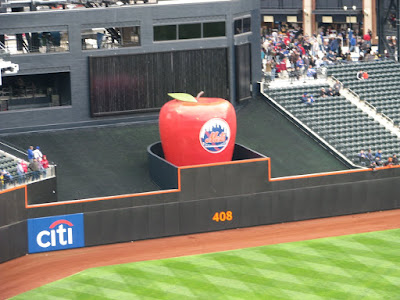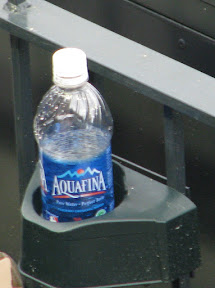Citi Field is still very much a work in progress. They’ve already changed the green to black around the Apple, for batter’s eye reasons. I’m thoroughly enjoying it so far, and I can’t wait to get there when it counts. Of course, that doesn’t mean that there aren’t things that went wrong, or that don’t seem quite right. I’m not going to whine and cry and count Mets banners and complain when it doesn’t meet my internalized quota, but I’ll point out my observations from my second trip. (Read about my first trip)
 |
| From Citifield |
While some people working their did seem friendlier, I did nearly get into a fight with the woman checking tickets at the Caesar’s club door. Stupidly of me, I let my hat blow off my head from the Promenade, and it landed one level down. I raced down the stairs to try to retrieve it, basically begged this woman to let me just grab my hat, and all she could do was utter variations of ‘No, go upstairs’. Eventually someone tossed the hat down the the field level, where the ushers were actually helpful.
 |
| From Citifield |
Since the concourses are set back under the seats Cow-Bell Man’s normal style of walking around the stadium would keep him away from the action and mostly unheard.
I had to sign for my $23 purchase at Box Frites. At least the line moved, and they’re slowly learning how to swipe, fill up sodas, find the buttons on the register and move a line.
The Promenade Club is too low down/embedded into the stands, so that the rows of seats just in front of it actually blocks the view of home plate from inside. I don’t know if there is anything to be done about it though.
The Mets really should reconsider the contract with whatever escalator company they use.
| From Citifield |
There are more seats at Citi with small obstructions here and there. (Although none as bad as back rows of the Loge) I had to stand to see Wright make any catches along the dugout. It’s one of the drawbacks of not building huge dizzying grandstands and keeping fans closer to the field.
Some people expressed dislike for the black and orange walls and the green seats. I don’t think any choice would’ve made me unhappy here so I may be biased, but I kind of like that the Mets stadium is built on top of a Polo Grounds look, with a Ebbetts Field entrance. It’s certainly not any of those parks in any way, and it is where we came from. Especially the Polo Grounds. The line? I’m curious how it will play out. It might just work.
I’m suspecting ceremony the 13th, when I’m not there, with putting the flags up.
 |
| From Citifield |
Blanche de Queens, one of the exclusive Citi Field beers out in the Taste of New York center field concourse, is excellent. As it’s name suggests, it’s kind of a white ale, similar to a Blue Moon. It was a full-bodied beer with plenty of flavor, while still being light and smooth. It was by far the best beer I’ve ever had at a sporting event. I can’t wait to try the Brooklyn Sabroso Ale next time. I tip my hat to Garrett Oliver and Brooklyn Brewery.
| From Citifield |

